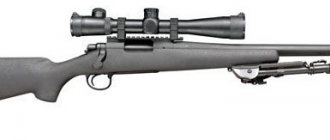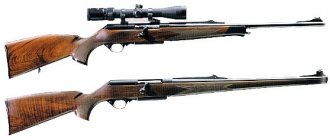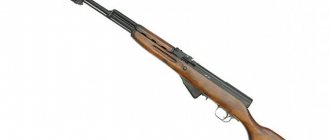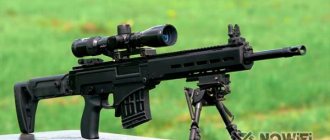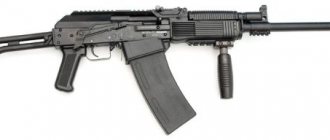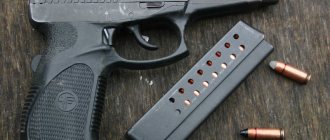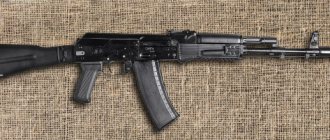Automatic carbine Simonov mod. 1945 Weapons have always personified strength, and the special peak of their development and modernization is war. This is the time when many types of weapons are produced and immediately used in combat. This happened with one of the famous carbines - the self-loading carbine of Sergei Gavrilovich Simonov (SKS-45). Work on it began during the Great Patriotic War, but as fate would have it, the first trial use was in 1945, when the war was nearing its end, and was adopted by the troops four years later. Therefore, for the same age as the Great Victory, a purely civilian application was found. Until now, soldiers of the honor guard in Russia are “armed” with a carbine; it is a mandatory attribute of parades, ceremonial meetings of heads of state of many armies of the post-Soviet space and the world.
Operating countries
Countries that use/used the Simonov self-loading carbine.
- British colony of Aden
- Albania Albania, in 1962, with the technical assistance of the People's Republic of China, production was mastered
- Algeria Algeria
- Angola Angola
- Afghanistan Afghanistan
- Bangladesh Bangladesh
- Benin Benin
- Bulgaria Bulgaria
- GDR GDRs Produced under license under the symbol Karabiner-S.
- Vietnam Vietnam
- Egypt Egypt
- Guinea Guinea
- Guinea-Bissau Guinea-Bissau
- Guyana Guyana
- Yemen Yemen
- Cambodia Cambodia
- Cape Verde Cape Verde
- PRC PRC
- Kazakhstan Kazakhstan is in service with paramilitary guards
- DPRK DPRK
- Comoros Comoros
- Laos Laos
- Liberia Liberia
- Madagascar Madagascar
- Mozambique Mozambique
- Oman Oman
- Romania Romania
- Russia Russia - in service with the 154th separate commandant and Presidential regiments, as well as units of the Private Security Service of the Russian Guard and the Departmental Security Service (VOKhR) of other ministries and departments of Russia (VOKhR ZhDT, etc.)
- Sao Tome and Principe Sao Tome and Principe
- Seychelles Seychelles
- Sierra Leone Sierra Leone
- Sri Lanka Sri Lanka
- Sudan Sudan
- Tanzania Tanzania
- Uganda Uganda
- Ukraine Ukraine is in service with the state security service. and Navy
- Equatorial Guinea Equatorial Guinea
- Yugoslavia Yugoslavia - a licensed copy of Zastava M59/66 was used
Device
The carbine consists of the following parts and mechanisms:
- Barrel with receiver, bayonet and sights
- receiver cover
- gate
- return mechanism
- gas tube with barrel lining
- gas piston
- pusher with spring
- firing mechanism
- shop
- box.
A clip is used to quickly fill the integral 10-round magazine. To use the clip, there are special guides on the bolt frame. When the cartridges are used up, when the magazine is empty, after the last shot, the bolt goes into a slide stop, which reduces the time for subsequent replenishment of the magazine with cartridges. Due to the increasing resistance of the spring and the excessive length of the curvature of the clip, clip loading requires certain skills, otherwise a delay may occur on the eighth cartridge. The cartridges should be pressed in, pressing as close to the clip as possible, and make sure that it does not bend forward.
SKS sights consist of a sight and a front sight. The sight, in turn, consists of a sight block with a leaf spring, an aiming bar and a clamp with latches and springs. The sight block has two sectors to give the aiming bar a certain height. On the bar there is a scale with divisions from 1 to 10 (indicating the firing range in hundreds of meters) and the letter “P” (permanent sight setting, corresponding to sight 3).
The bayonet is a bladed, permanently folding one, consisting of a blade with a base and a tube with a spring (providing shock absorption of the bayonet for uniform SKS combat, regardless of the position of the bayonet). Some early carbines had a needle bayonet.
The carbine kit includes: accessories (cleaning rod, cleaning rod, brush, drift, pencil case and oil can), belt, cartridge bags and clips.
Reloading of the SKS after the next shot is carried out automatically, for which the energy of the powder gases removed from the barrel is used. The barrel bore is locked by tilting the bolt downwards. On early samples the barrel was black-forged, since 1952 it was chrome-plated.
Automation operating principle
Main article: Removal of powder gases
At the moment of firing, when the bullet passes through the barrel, powder gases under high pressure rush through a special hole in the barrel wall into the gas chamber, where they set in motion the gas piston, the pusher, and with it the bolt. The bolt, in turn, opens the barrel, compresses the return spring and cocks the hammer. In this case, the cartridge case is removed from the chamber and thrown out.
Next, the bolt, under the action of the return mechanism, returns forward, sending a new cartridge into the chamber and closing the barrel bore. The side face of the bolt frame rests against the combat stop, and the locking protrusion of the bolt stem holds the bolt frame in this position. After this, to fire, you must release the trigger and press it again.
When the last cartridge is fired, the bolt will rest on the bolt frame and will not move further, which is a signal to the shooter about the need to reload.
Disassembly, assembly and maintenance
Partial disassembly of the SCS is carried out for cleaning, lubrication and inspection in the following order:
- removing the pencil case with accessories from the butt;
- cleaning rod compartment;
- separation of the receiver cover;
- removing the return mechanism;
- removing the shutter;
- separation of the frame from the bolt stem;
- separation of the gas tube with the barrel lining.
Reassembly after partial disassembly is carried out in the reverse order.
Complete disassembly of the SCS is carried out for cleaning in case of heavy contamination, after exposure to rain or snow, when switching to a new lubricant and repair in the following order:
- incomplete disassembly;
- removing the pusher with the spring;
- firing mechanism compartment;
- store branch;
- separation of the barrel with the receiver from the stock;
- disassembling the trigger mechanism;
- disassembling the return mechanism;
- separation of the firing pin and ejector from the bolt body.
Reassembly after complete disassembly is carried out in the reverse order.
It is recommended to use gun lubricant and alkaline composition (to remove powder deposits) in summer (at temperatures above 5 °C), and in winter (from +5 °C to −50 °C) to use liquid gun lubricant (for lubrication and removal of deposits) , carefully removing (by washing all metal parts in kerosene or liquid gun lubricant, thoroughly wiping with a rag or tow, then rinsing again and wiping with a clean rag) before doing this the summer lubricant. For long-term storage, the carbine is generously lubricated with a mixture of 50% gun lube and 50% gun lube by dipping the cleaned metal parts twice into baths of hot lube.
Disassembly, assembly and maintenance
To perform cleaning, lubrication, maintenance and repair work, the Simonov SKS 45 self-loading carbine can be partially or completely disassembled.
Partial disassembly of the SKS carbine is carried out for its cleaning, lubrication and maintenance. In order to perform partial disassembly of the SCS, perform the following steps:
- Make sure the carabiner is completely unloaded
- Remove the pencil case with accessories from the butt, separate the cleaning rod
- Separate the receiver cover from the carbine
- Remove the return mechanism
- Remove the bolt
- Separate the frame from the bolt stem
- Separate the gas tube from the barrel lining
- Remove the gas piston
Reassembling the SKS carbine after partial disassembly is carried out in the reverse order.
The carbine is completely disassembled for cleaning if it is heavily soiled, after the carbine has been exposed to rain or snow, when switching to a new lubricant, or to perform necessary repairs. It is advisable to carry out complete disassembly of the carbine indoors in an equipped workplace.
How to distinguish OP-SKS from SKS-45
The difference between the civilian version of the SKS and the one supplied to the troops is very slight, as can be seen in the photos of the carbine presented. The difference lies in the absence of a bracket on which the folding bayonet is attached, the barrel is “pinned” to ensure ballistic identification and the length of the sighting bar is shortened.
With its help, targeted shooting is possible only at a distance of up to 300 meters. The differences between the OP-SKS and SKS-45 are quite insignificant and therefore only a person with experience in handling rifled weapons can see them right away.
During the conversion of the army version of the carbine, no changes were made to its design. There are no connecting screws at all, all parts are made using milling.
Only the magazine covers and housings are made using the stamping method. Having retained its original positive characteristics, OP-SKS has earned high marks from hunters.
Expert opinion Dmitry Timofeevich Tarasov Master of Sports in mountaineering. Author of scientific articles on the topic of survival in the wild
Hunting wood grouse in the fall with the OP-SKS carbine is very effective. Despite the fact that the design of the civilian version of the carbine uses a method of locking the barrel with a skew, this design solution finds many of its supporters.
Its maintenance is simple and inexpensive. The absence of technological cavities on the bolt frame and box prevents dirt and dust from accumulating inside the carbine.
Cleaning weapons does not require a lot of time and complex equipment. The failure-free operation of the SCS mechanisms allows its operation in the absence of maintenance for a year. The peculiarity of the OP SKS lies in the method of loading it.
For a person accustomed to handling Kalashnikov weapons, clip-on loading will be somewhat unusual and will require certain skills. But this is just a matter of practice.
In fact, only errors made during loading are the cause of many failures during shooting. All mechanisms of the carbine work flawlessly and are not the cause of misfires.
Options
Hunting and fishing carbines were developed on the basis of the SCS:
- OP-SKS
(
about
hunting-
promyslovy
) - SKS, converted at the Tula Arms Plant from a military weapon into a hunting weapon by removing the bayonet lug, limiting the aiming bar with a pin to 300 meters and applying new markings (according to the Law “On Weapons”). Otherwise, SKS and OP-SKS are completely the same. - TO3-97 “Arhar”
is a variant developed at the Tula Arms Plant and differs from the SKS in the mount for the PO-4×34 optical sight and a modified wooden or plastic stock, more suitable for hunting. The sighting bar is limited to 300 meters, there is a pin in the barrel. - KO SKS
(
K
Arabin
o
Khotnichy) is a variant of TsKIB SOO. - NPO Fort produces two modifications: SKS-MF
(Soviet SKS carbines without a bayonet) and
Fort-207
(Soviet SKS carbines with a new forearm and butt made of black plastic) - VPO-208 is a modification of the SKS chambered for the .366 TKM cartridge. Manufactured by Molot-oruzhie LLC. It has a newly manufactured partially rifled barrel with rifling in the muzzle (Paradox). The tide does not cut down under the bayonet. The muzzle of the barrel has a thread for installing a muzzle brake-compensator. It is a smooth-bore weapon (according to the Law “On Weapons” 150FZ).
- VPO-208L is a modification of the SKS chambered for the .366 TKM cartridge. Manufactured by Molot-oruzhie LLC. It has a smooth barrel made by rotational forging with an oval Lancaster screw drill along the entire length of the barrel bore. The tide does not cut down under the bayonet. It is a smooth-bore weapon (according to the Law “On Weapons” 150FZ and GOST 28653-90 “Small arms. Terms and definitions”).
- SKS-366-Lancaster is a modification of the SKS chambered for the .366 TKM cartridge. Produced by Hammer Arms LLC. It has a smooth barrel made by rotational forging with an oval-helical Lancaster drill along the entire length of the bore. The tide does not cut down under the bayonet. It is a smooth-bore weapon (according to the Law “On Weapons” 150FZ and GOST 28653-90 “Small arms. Terms and definitions”).
These carbines are very popular among commercial hunters due to their low price, ease of maintenance, unpretentiousness and reliability. The carbine operates reliably at temperatures from −50 to +50 degrees Celsius (an indicator of the high reliability of the SKS is the fact that this particular carbine was taken with them by the participants of the Transarctic 2006 expedition for protection from polar bears). It is generally accepted that these SKS variants are mainly used for shooting fast and relatively small animals such as wolves or foxes, since the 7.62x39 mm cartridge does not effectively hit large game. At the same time, it is necessary to take into account that the common opinion about the insufficient effectiveness of the 7.62x39 cartridge in traditional Russian hunting can only be substantiated by comparing this caliber with a obviously more powerful one (for example, 7.62x54 mm R). The weak stopping effect of a standard military cartridge bullet (and not the low efficiency of the cartridge as a whole, as is commonly believed), coupled with the inability to shoot, is the main reason for all sorts of stories about moose and wild boars with dozens of wounds. The problem is solved by using hunting ammunition with semi-jacketed or expansive bullets in hunting, which have a sufficient stopping effect when hitting a medium-sized animal (wolf, wild boar, deer, bear, roe deer) and ensure confident defeat of game, as well as comprehensive training of hunters’ accuracy - up to passing the standards before hunting season.
Considering the huge number of SKS that is currently in warehouses, in the Russian Federation, Ukraine, Belarus and other republics of the former Soviet Union there are a number of enterprises that are engaged in converting SKS carbines into OP-SKS and Arhar, after which the carbines are already in civilian option are supplied to the retail chain.
Ammo
Main article: 7.62×39 mm
A pack of 8 rounds of .30-06 cartridges for the M1 Garand rifle and a clip of 10 rounds of 7.62x39 mm cartridges for the SKS.
Shooting from the SKS is carried out with cartridges of the 1943 model (7.62×39 mm) with the following types of bullets:
- ordinary (surrogate) with a steel core
is designed to defeat enemy personnel located openly or behind obstacles pierced by a bullet. The shell is steel clad with tombac, the core is steel, and there is a lead jacket between the shell and the core. Has no distinctive coloring. - The tracer
is designed for target designation and fire adjustment at distances of up to 800 m, as well as defeating enemy personnel. The core consists of an alloy of lead and antimony, behind which there is a cup with a pressed tracer compound. The color of the head part is green. - armor-piercing incendiary
is designed to ignite flammable liquids and destroy manpower located behind lightly armored shelters at ranges of up to 300 m. The shell is with a tombak tip, the core is steel with a lead jacket. Behind the core in a lead pan there is an incendiary composition. The color of the head part is black with a red belt. - the incendiary
is designed to ignite flammable liquids in iron tanks up to 3 mm thick, flammable materials at ranges up to 700 m and target designation at distances up to 700 m. The incendiary composition is located between the shell (with a tombak tip) and the steel core, the jacket is steel. Behind the core and jacket there is a cup with a tracer compound. The color of the head part is red. - hunting, shell, with a lead core,
intended for hunting and training shooting. The shell is steel clad with tombak, the core is lead.
Description
The RPG-32 is designed to destroy a wide variety of targets - modern main battle tanks and other armored vehicles, bunkers and enemy infantry.
The RPG-32 consists of a reusable launcher (launching device) with a standard collimator sight and disposable launch containers (multi-caliber cartridges) with rocket-propelled grenades, equipped at the manufacturer. In addition to the collimator, optical or infrared night sights can be installed.
The main caliber is 105 mm (72 mm grenades can also be used). The length in the combat position is 900-1200 mm, the weight in the combat position is 6 kg (with a 72 mm grenade in a container) or 10 kg (with a 105 mm grenade in a container). The effective firing range is 200 m, the sighting range is 700 m. The 105-mm grenade is equipped with a tandem cumulative warhead and is optimized for hitting main battle tanks with dynamic protection. This 105 mm PG-32 grenade penetrates 600 mm of steel armor behind dynamic protection. A distinctive feature of the RPG-32 is the same ballistics of all shots, which significantly reduces the training time for soldiers.
History of creation
The 7.62 x 39mm intermediate cartridge, created in 1943, marked the beginning of the development of a completely new weapon capable of taking infantry power to a new level. It is not surprising that over the next few years several successful types of weapons were created at once: the Kalashnikov assault rifle, the Degtyarev machine gun and the Simonov self-loading carbine, also known as SKS.
It is worth noting that this carbine was not the first creation of the famous designer. Previously, he developed another model, which did not go into mass production only because some of the factories were evacuated to the rear due to the outbreak of the war.
The appearance of a new cartridge made it possible to use old developments to create new weapons. The new carbine was created in 1944, but over the next few years it was refined and perfected.
Therefore, it was put into production only in 1949, when it entered service with the army.
The SKS carbine did not remain in service for long. Experts already predicted that urban battles would prevail in the future.
Therefore, preference was given to the AK rather than the SKS. Although it was not completely removed from service - back in the 80s of the last century it was used by military personnel of engineering and military construction units.
Later, the carbine became available to hunters, but more on that later.
War experience and new horizons
Before considering the carbine, which is already quite overgrown with legends, and the cartridge for which it was designed (rail-piercing, of course), it is necessary to understand the background and conditions in which it was created.
SCS scheme
We certainly joked about the rail, but everything else really played a big role in the emergence of the SCS and its adoption into service in our country. Sergei Simonov was an experienced gunsmith. At the time of the creation of the SKS, he already had a unique automatic rifle chambered for the powerful 7.62x54R cartridge and a very successful self-loading PTRS anti-tank rifle chambered for 14.5 mm caliber. These two weapons, like the experienced carbines that were the “harbingers” of the SKS, left their mark on the future SKS. But the main factor was war - a difficult test not only for people, but also for weapons. The wide temperature ranges of our fronts, front-line dirt and dust, a severe enemy armed with good weapon systems and the latest cartridges - all this forced our designers to look for new approaches and techniques in the weapons business.
SKS with attached and retracted bayonet
The enemy’s successful use of small arms chambered for the so-called intermediate cartridge prompted the idea of creating similar domestic cartridge-weapon systems. The appearance of the Soviet intermediate cartridge, now known throughout the world as 7.62x39 mm, made it possible to compete with the successful German Sturmgever and gave rise to controversy (by the way, still going on to this day) regarding the Kalashnikov assault rifle.
This is how the clip was loaded into the SKS
But there were no such disputes with SCS, but there is one interesting myth. Many gun lovers mistakenly believe that the SKS was tested at the front in the form and caliber that we know now. This is wrong. The Simonov family of carbines, by the way, which he had been developing since pre-war times, initially implied the use of a full-size rifle cartridge. Examples such as the SVS-53 were produced back in 1940. Then SKS-30 and SKS-31 were tested. These carbines have actually been tested in active service, at Shot courses, at factory and military training grounds. It was this colossal experience gained in working on a whole family of rifles and carbines that gave Simonov the opportunity to create a masterpiece of weapons thought, which received the SKS-45 index.
Main advantages
Speaking about the advantages of this weapon, first of all it should be noted the low weight and good sighting range - but this has already been mentioned above.
In addition, experts highly value its reliability. The design was simplified as much as possible - in Soviet times, each weapon underwent extremely serious testing in field tests. Any weapon that was unable to fire without extensive cleaning was immediately rejected. Therefore, there is nothing to say about reliability.
An additional advantage for modern hunters is low cost. If we compare, for example, with a rifled Saiga, created for the same caliber, it turns out that the cost of the SKS is 2-3 times lower. Quite a good saving! The same can be said about cartridges - they are among the most frequently produced in our country, so their price is quite low.
Obtaining a weapons permit
Since the SKS is a rifled weapon (except for modifications like Lancaster and VPO-208), Russian citizens can purchase it only if they have five years of experience in owning smooth-bore weapons.
To do this, you need to go to the OLRR at your place of residence to write an application for permission to purchase rifled weapons. The maximum processing time is 2 weeks. Once the permit is issued, the gun enthusiast has only a month to obtain a license to purchase. And for this you will need to collect:
- Medical certificates No. 002-O/u (issued at the hospital after examination by the relevant doctors) and No. 003-O/u (can be taken from a narcologist after passing tests).
- Passport.
- Certificate of completion of a firearms safety course.
- Receipt for payment of state duty.
The package of documents is reviewed up to 30 days. Most likely, during this time the district police officer will check whether the applicant has a safe and whether it meets the requirements.
When purchasing a rifle, the permit is neatly divided into three elements - there are special dotted lines on it. The seller retains the license, but the license is handed over to the OLRR and the buyer retains duplicates. When purchasing, a control shooting is required, on the basis of which a protocol is drawn up.
When leaving the store (or from the OLRR, if the weapon was purchased second-hand), the new owner, in addition to the weapon, must also have a test shooting protocol and a technical passport for the weapon.
After this, you need to go to the OLRR again to register the weapon and obtain a permit to store and carry it. The maximum period is 2 weeks. It is better not to delay this - even a daily delay may well result in an article, in the best case, of the administrative code.
To complete the entire procedure without unnecessary delays, you will need:
- Passport.
- Two photographs measuring 3x4 centimeters.
- Duplicate with store mark.
- A copy of the technical passport.
When you come to the OLRR, you must write a corresponding application.
Once permission is received, you can forget about the need for additional paperwork for five years. After this period, the permit will have to be renewed for another period of the same period.
Tuning options
Another important advantage of SCS is its extensive tuning capabilities. If the owner is not too limited in funds, then on the basis of a simple carbine you can create a real work of art
Depending on the needs of the owner, the weapon can be modified in any way. Optical sights are installed, a bipod is installed, the stock and forend are changed, and instead of a fixed magazine, new ones with a larger capacity appear.
As a result of this modification, the weapon is simply no longer recognizable. At the same time, its reliability and simplicity do not suffer, of course, if the work is performed by experienced craftsmen. Yes, extensive tuning is quite expensive. But, according to the owners, every ruble spent is fully compensated by the increased ease of shooting.
Existing disadvantages
Unfortunately, any weapon has certain disadvantages. SKS is no exception.
According to many experts, the carbine has only two disadvantages, but they are extremely serious: small magazine capacity and difficulty in reloading. Indeed, although the 10-round magazine seemed very spacious compared to the Mosin rifle, which the SKS was supposed to replace, it was seriously inferior to the same AK with 30 rounds.
But what’s even worse is that charging is carried out using clips. You must first load the clip with cartridges, then retract the bolt, insert the clip of cartridges into the magazine, pull it out, return the bolt to its original position, sending ammunition into the barrel, and only then fire. Of course, it is almost impossible to quickly do this in the heat of battle, when due to a sharp surge of adrenaline, even an experienced fighter cannot easily replace the magazine on a Kalashnikov assault rifle.
Some features of using a carbine
When using this weapon, it is worth remembering that the SKS-45 is a carbine designed for the average Soviet soldier. The weapon was developed strictly according to the requirements for combat qualities and performance characteristics that were relevant at that time. Although its production was massive, the level of production still remained very high. The weapon is not without a certain degree of grace and has its own charm.
Of course, the design of the carbine is typical of the 30s of the twentieth century and contains many outdated solutions, such as loading with a clip. However, its fighting qualities can be called high even by modern standards. Of course, hunting modifications of the carbine differ from combat modifications. They do not have a bracket for installing a bayonet, and there are also markings on the receiver. The passport of the SKS hunting rifle contains the same notes. By the way, another reason for the popularity of this carbine is the possibility of free purchase under a standard license to own a hunting weapon. The price is quite reasonable - up to 10 thousand rubles.
Of course, there are plenty of competitors on the market. First of all, these are the popular Saiga and Vepr hunting carbines, but they are more expensive and do not carry historical value, although they are more practical.
Any hunter must remember that the SKS is a carbine whose technical characteristics are at the combat level, and whose quality and reliability have been tested by more than one generation of soldiers and hunters.
Shooting
To zero in the SKS carbine, it is recommended to go to a shooting range or wait for a clear and windless day, since the trajectory of a ballistic projectile is influenced by a huge number of natural factors: precipitation, air humidity, wind strength, and so on. It is also advisable to use a special locking machine, which allows you to achieve a stationary position of the weapon during zeroing. If this is not possible, then any convenient horizontal surface or a bag filled with sand is used as a support.
SKS shooting is carried out with live ammunition at iron targets with shooting range markings, which are located at a distance of 20 meters from the shooter. If you want to zero your optics or collimator, it is recommended to do a cold zero first in order to save ammunition. To do this, you will need to align the aiming bar on the lens with the front sight. You can also use special lasers that are placed in the muzzle of a weapon. After this procedure, the weapon will be practically configured. You will only need to fire a few shots to be sure of this.
If you decide to immediately start hot shooting, then under no circumstances rush. When adjusting the optics, adjust only one position at a time - vertical or horizontal. Otherwise, you risk getting confused in the calculations and losing a lot of time shooting. After the difference between the point of impact of the projectiles and the aiming point is minimal, we increase the distance to the targets and repeat the procedure.
The final zeroing of the SKS carbine in natural conditions is carried out from a distance of no more than 300 meters. Shooting at a distance above this indicator is considered sniper and requires the shooter not only practical skills, but also theoretical knowledge. As mentioned in the weapon characteristics section, the direct shot distance is approximately 365 meters. After this, the bullet will lower its trajectory under the influence of gravity. Plus, even the slightest breath of wind can move a ballistic projectile several meters to the side.
Design
Vepr carbines are produced for cartridges 7.62×39 mm, 7.62×51 mm NATO (.308 Winchester), 5.56×45 mm NATO (.223 Remington), 7.62×54 mm R, 7, 62x63 mm (.30-06 Springfield), 9.6/53 Lancaster, .366 TKM in several different modifications and versions.
The carbine is based on the Kalashnikov light machine gun and has a high degree of reliability and reliability when operating in various operating conditions.
Automatic reloading of the carbine is carried out by using the energy of the powder gases removed from the barrel bore into the gas chamber when fired, and the energy of the return spring.
To increase durability, the barrel bore and chamber of the carbine are chrome-plated; to reduce the flash of flame when fired, a permanent flash suppressor is installed on the muzzle of the barrel.
To eliminate possible inertial pinching of the primer on imported cartridges, the bolt striker is spring-loaded.
To increase safety, the Vepr series carbines are equipped with a flag-type safety lock. The stock is combined, with a pistol grip. A rubber butt pad-shock absorber is installed on the butt to reduce recoil.
To mount the optical sight, a dovetail-type side mount is used, identical to the Kalashnikov assault rifle.
The sighting bar of the Vepr series carbines allows for effective shooting at a distance of up to 300 m.
"Bars-4"
Continuing to review domestic weapon models, one cannot help but mention the Bars hunting carbine. Unlike the two previous options, this rifle is designed for hunting small fur-bearing animals or birds. Although one cannot fail to note its reliability and unpretentiousness to the conditions of use (temperature range is from -50°C to +50°C).
This carbine was chambered for 5.6 x 39 mm cartridges. It has a fairly convenient trigger mechanism that allows the hunter to adjust the stroke of the trigger, the nature of the descent and the effort that must be applied to shoot. It comes with three-fold optics, but shooting through an open sight is also possible.
The weight of the weapon is only 3 kilograms with a barrel length of more than 1000 millimeters. For ease of use during hunting, the weapon was equipped with a magazine for five rounds, as well as a wooden butt made of hazel. In general, if you want to hunt ducks from the approach or hunt a hare, then you simply cannot find a better option.
Using a carbine for hunting
From the point of view of a hunting weapon, the SKS carbine has quite good technical characteristics. Of course, compared to currently existing cartridges, the 1943 model bullets are not particularly suitable for combat missions, but they can play a big role for amateurs and professionals in hunting. The SKS is ideal for hunting wolves, ungulates, and any animal weighing up to 100 kg. The cartridge's bullet remains effective at a distance of 150 - 200 meters, while targeted shooting (using optics or an open sight) can be carried out up to 300 meters.
Of course, this weapon can only give a lot of trophies to a skilled hunter. The dispersion when shooting is insignificant, the light weight and convenient shape allow you to hit the target even when shooting offhand, and the use of special hunting cartridges increases the chance of hitting a target with one shot many times over.
Specifications
The SKS also boasts impressive combat characteristics, which are presented in the weapons passport in the form of the following table:
| Characteristic: | Parameter: |
| Caliber: | 7.62 mm |
| Barrel type | threaded |
| Ammunition used | 7.62×39 mm |
| Carbine length excluding bayonet | 1120 mm |
| Barrel length | 520 mm |
| Bullet range | 3600 mm |
| Sighting range | 1000 mm |
| Magazine capacity | 10 rounds |
| Rate of fire | 40 rounds per minute |
| Weapon weight | 3.75 kg |
As for the accuracy of the battle, the spread is no more than 6 centimeters when fired from a distance of 100 meters - a very good indicator for rifled weapons. Tests were carried out using classic military ammunition.


